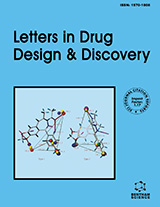Abstract
Background: The endogeneous antioxidant mechanism often fails to combat the huge free radical overload necessitating external antioxidant supplementation. Thus identification and definite structural manipulation of the naturally available antioxidant derivatives using in silico methodology help to design new moieties with improved therapeutic potential.
Objective: The present work has been performed with the aim to identify the essential molecular fragments that contribute to the antioxidant property of the coumarin derivatives.
Method: In this work three separate chemometric methods were utilised to highlight the structural requisites of the coumarin derivatives.
Results: The QSAR model thus developed helps to highlight the prime molecular fragments, while the 3D pharmacophore model denotes the features constituting the biological pharmacophore for the coumarin derivatives. Again, the HQSAR contour signifies the relative contribution of the different molecular fragments.
Conclusion: In silico techniques thus adapted in the present work highlight a significant paradigm in the process of screening and designing therapeutically active antioxidant moieties.
Keywords: Antioxidants, coumarin, QSAR, 3D pharmcophore, HQSAR.
Graphical Abstract
Current Computer-Aided Drug Design
Title:Quantitative Analysis of Essential Molecular Features of Coumarin Derivatives with Antioxidant Activity Using Chemometric Tools
Volume: 12 Issue: 3
Author(s): Biplab De, Indrani Adhikari, Ashis Nandy, Achintya Saha and Binoy B. Goswami
Affiliation:
Keywords: Antioxidants, coumarin, QSAR, 3D pharmcophore, HQSAR.
Abstract: Background: The endogeneous antioxidant mechanism often fails to combat the huge free radical overload necessitating external antioxidant supplementation. Thus identification and definite structural manipulation of the naturally available antioxidant derivatives using in silico methodology help to design new moieties with improved therapeutic potential.
Objective: The present work has been performed with the aim to identify the essential molecular fragments that contribute to the antioxidant property of the coumarin derivatives.
Method: In this work three separate chemometric methods were utilised to highlight the structural requisites of the coumarin derivatives.
Results: The QSAR model thus developed helps to highlight the prime molecular fragments, while the 3D pharmacophore model denotes the features constituting the biological pharmacophore for the coumarin derivatives. Again, the HQSAR contour signifies the relative contribution of the different molecular fragments.
Conclusion: In silico techniques thus adapted in the present work highlight a significant paradigm in the process of screening and designing therapeutically active antioxidant moieties.
Export Options
About this article
Cite this article as:
De Biplab, Adhikari Indrani, Nandy Ashis, Saha Achintya and Goswami B. Binoy, Quantitative Analysis of Essential Molecular Features of Coumarin Derivatives with Antioxidant Activity Using Chemometric Tools, Current Computer-Aided Drug Design 2016; 12 (3) . https://dx.doi.org/10.2174/1573409912666160721153935
| DOI https://dx.doi.org/10.2174/1573409912666160721153935 |
Print ISSN 1573-4099 |
| Publisher Name Bentham Science Publisher |
Online ISSN 1875-6697 |
 50
50 4
4 2
2 2
2
- Author Guidelines
- Bentham Author Support Services (BASS)
- Graphical Abstracts
- Fabricating and Stating False Information
- Research Misconduct
- Post Publication Discussions and Corrections
- Publishing Ethics and Rectitude
- Increase Visibility of Your Article
- Archiving Policies
- Peer Review Workflow
- Order Your Article Before Print
- Promote Your Article
- Manuscript Transfer Facility
- Editorial Policies
- Allegations from Whistleblowers


























